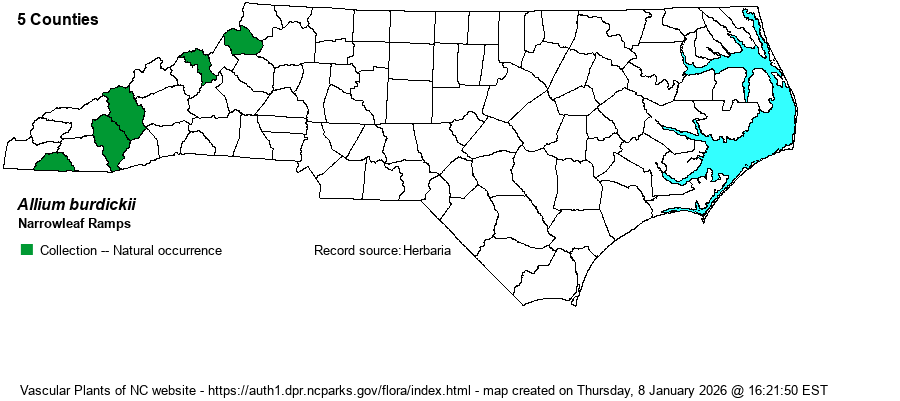| Author | (Hanes) A.G. Jones | |
| Distribution | This species (or taxon) is known from several SERNEC collections made over five montane counties. As it looks similar to the locally common Red Ramps (A. tricoccum), with which it is often included as a variety, it can certainly be overlooked or misidentified. Thus, it is tentatively known to occur only in the Mountains, at higher elevations.
This is a Northern and Midwestern species, as is A. tricoccum, but it seems to be rather scarce over much of its wide range. It ranges, according to Weakley (2024) from "ME west to ND and south to NJ, and in the Mountains to w. VA, w. NC, and n. GA". | |
| Abundance | Currently considered by this website as very rare to rare in the Mountains, but in reality it is of uncertain abundance there. Weakley's (2024) map shows it as "rare" in the NC Mountains. The NCNHP has its State Rank as a seemingly proper S1? until more is known about this taxon's distribution in the state and has placed it on the Watch List (W7). | |
| Habitat | Weakley (2018) says "Northern hardwood forests, primarily at higher elevations than A. tricoccum, also in cove forests and rich slopes." However, it is likely that there are elevation and habitat overlaps with these two species, and one should not identify A. burdickii by habitat or elevation. | |
| Phenology | Blooms mainly in June, and fruits mainly in August. As with Red Ramps, the leaves emerge in April and have withered by late May or early June, before the flowering scape emerges. | |
| Identification | This species (or variety of A. tricoccum according to some references) is quite similar to Red Ramps in appearance. However, it has two narrow strap-like basal leaves that are often just 1 inch wide, they have essentially no petiole visible above ground, and the lowest part of the leaves is white. Red Ramps has leaves typically 2 inches wide, and they have a narrow but obvious petiole that is reddish or pinkish. In addition, the erect umbel of creamy flowers has many fewer flowers, typically 10-18, than found on Red Ramps (typically 30-55 flowers). Several of the specimens at NCU (University of North Carolina herbarium) are of flowering stalks, with only perhaps 15 flowers in the umbel. However, it is not certain if one could prove these are true A. burdickii and not depauperate specimens of A. tricoccum, though it is hoped that the identifications are indeed correct. | |
| Taxonomic Comments | As indicated above, some references, such as Weakley (2024), consider this as a valid species. The Flora of North America website and some others such as NatureServe have this entity as just a variety -- A. tricoccum var. burdickii.
| |
| Other Common Name(s) | Narrowleaf Wild Leek, White Ramps | |
| State Rank | S1? | |
| Global Rank | G5T5 [G5] | |
| State Status | W7 | |
| US Status | | |
| USACE-agcp | | |
| USACE-emp | | |

